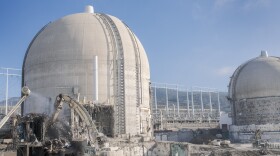Board members of the San Diego Association of Governments (SANDAG) on Friday held their first open debate on the agency's freshly unveiled long-range transportation plan, with familiar fault lines emerging over freeway expansions and housing density.
The plan envisions a massive boost in public transit in the coming decades, with faster and more frequent bus and trolley services and roughly 200 miles of new high-speed commuter rail. Gaps in the transit network would be filled by a "flexible fleet" of shared bikes, scooters and on-demand shuttles.
But the transit expansion's success depends on cities across the region dropping their long-held opposition to high-density housing. Mayor Todd Gloria said the new transit service should make it easier for communities to accept that transition from low-density suburbs to more compact, walkable neighborhoods.
"It's often asked, 'Where's the infrastructure?'" Gloria said. "Well this plan describes where some of the infrastructure will come from. And I'm pleased that the infrastructure that is proposed is multimodal in nature, actually giving San Diegans real choices that they don't currently enjoy."
Four cities — Coronado, Solana Beach, Imperial Beach and Lemon Grove — are currently suing SANDAG to lower the number of new homes they're required to plan for over the next decade. All those cities saw big jumps in their housing mandates due to changes in state law. A judge dismissed their complaint, but the cities are appealing.
RELATED: Housing Crisis Shifts Conversation On Where New Homes Belong
Solana Beach Mayor Lesa Heebner praised the plan's transportation element but said cities should be allowed to preserve their "uniqueness" through local zoning authority.
"The cities are the ones who know best," she said. "We'd like to zone as much as we can near transit, but it’s not always possible."
SANDAG Executive Director Hasan Ikhrata said the mayors, city council members and county supervisors who make up the agency's governing board should be looking beyond the concerns of today and consider the needs of future generations.
"Some of these elements of the plan are politically hard," Ikhrata said. "We're reimagining the future of the transportation system. We're allowing San Diegans to dream, but the only way they're going to achieve this dream is if you as leaders make it possible for them."
In stark contrast to previous plans from SANDAG, this one does not include traditional freeway widenings. Some highways would see added capacity, however, by converting existing lanes and shoulders into carpool and toll lanes that would get more expensive during rush hour.
RELATED: How COVID-19 Is Changing San Diego’s Transportation Planning
That's sparking pushback from more conservative SANDAG board members who have long sought congestion relief through widenings.
"I feel that there needed to be more benefit to North County in and around the 78 corridor and most importantly the I-5 corridor — not just for the vehicles that we drive, but also for goods movement," said Carlsbad Mayor Matt Hall. "So at this moment in time if I was to vote on this I would not be able to support it."
A number of studies have shown that freeway widenings encourage more driving and do not reduce congestion.
Funding the plan is also contentious — its overall price tag of $160 billion is larger than previous plans. To cover the higher costs, local elected officials and voters would have to approve a one-cent sales tax increase, according to the plan. The plan also foresees a four-cent-per-mile fee to account for a future with more electric vehicles and dwindling gas tax revenues.
The draft regional transportation plan is open for public review until July 30. SANDAG board members are expected to cast a final vote on the plan by December.






